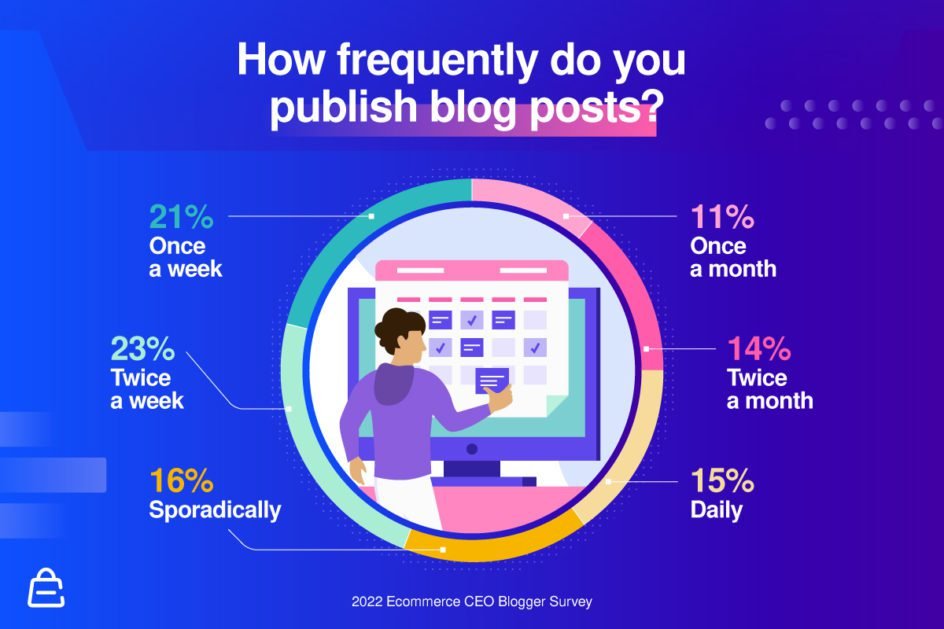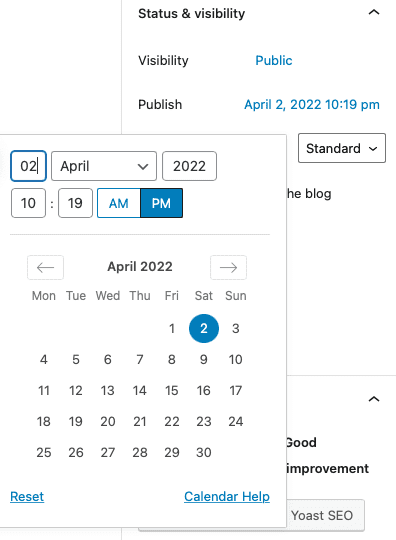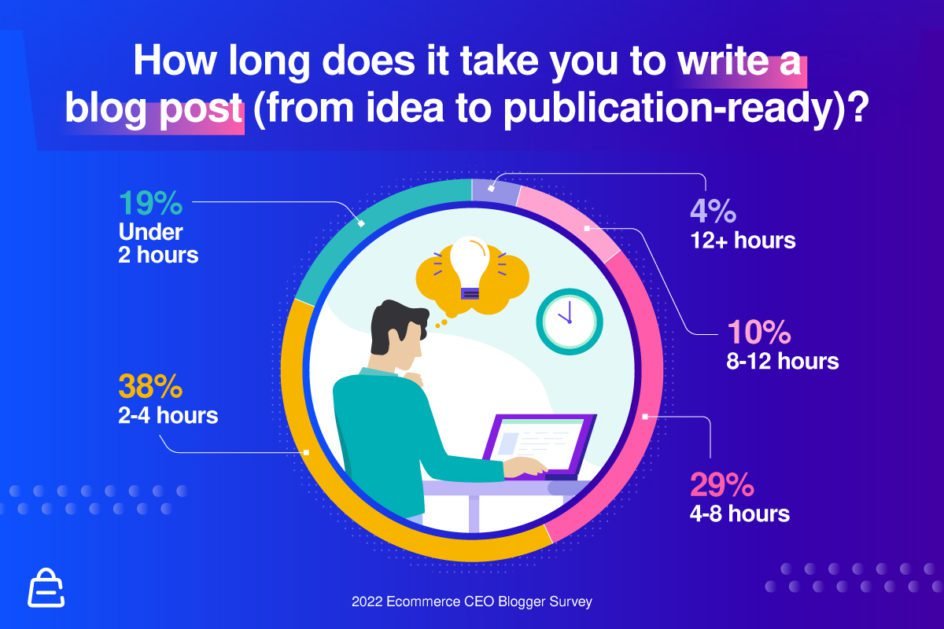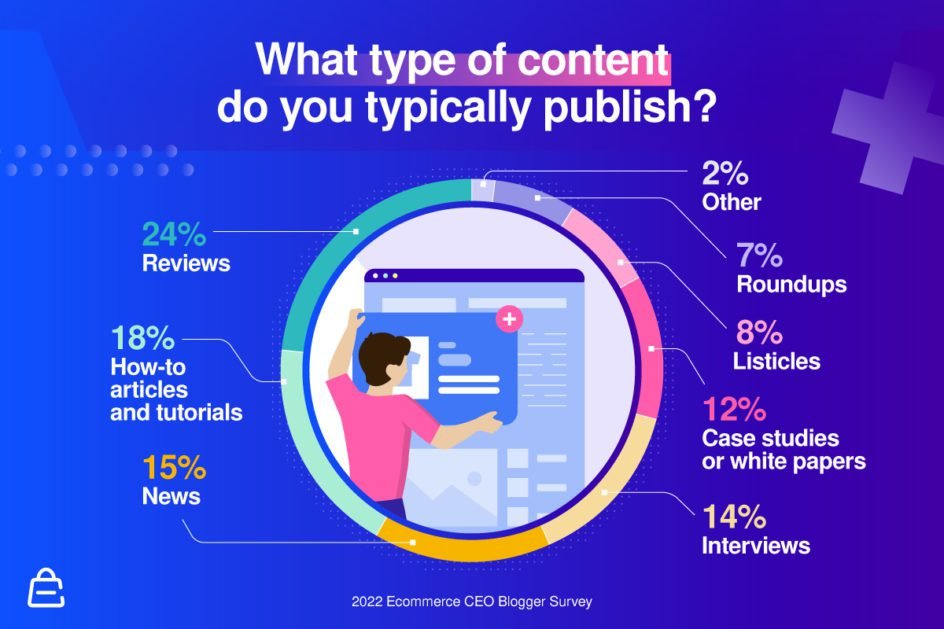Putting together a new blog means weighing your options. What will the subject be? What will the design look like? What will you name it? Will you monetize the endeavor?
It’s a lot to consider.

And we hate to add to the pile of things to do, but you also need to think about how often you’ll write blog posts – and this isn’t exactly a minor decision.
Blogging frequency can play a major part in how your blog is received and its overall success.
Today, we’ll discuss why blog frequency matters, review what professionals think, then discuss the ideal blog posting schedule – with a few tips for coming up with your own.
Why Blogging Frequency Matters
As we teased in the introduction, how often you publish new posts actually matters a great deal to your blog’s overall success and content marketing strategy. The data backs up this claim.
The total number of pages you have published on your website directly impacts the amount of traffic you receive.
That is, the more published pages you have, the more traffic you get.

According to a study conducted by Traffic Generation Cafe, blogs see a 77% increase in traffic after logging at least 50 published posts. 77%! And that ties directly into your ability to make money from your blog as well.
Why this occurs is common sense in a lot of ways. When you’re publishing new content consistently, your blog is always being re-indexed by search engines.
Spiders will continue to crawl your site’s pages and make connections between the content because you’re always giving your site a boost or a refresh.
But a higher published blog post frequency can result in more traffic in other ways as well. Current readers of your blog will think of your content more often and come back to read your latest posts.
Newly published posts on a regular schedule ensure your blog stays fresh in your target audience’s minds.
Likewise, having fresh posts to share on social media accounts means more people will click on your social links. That’s more eyeballs on your blog and still another benefit of publishing regularly.
“How Often Should I Blog?” Professionals Answer
How often to blog is a decision that relates to how quickly you want your blog to grow, the amount of material you aim to cover, and what your personal schedule looks like.
So the schedule you settle on will depend mostly on these factors. However, we recently surveyed professional bloggers to see what the real pros had to say on the subject.
The survey results showed that 23% of respondents publish two blog posts per week, while 21% publish posts once a week.

And 15% publish daily posts. That works out to 59% of all bloggers surveyed publishing at least once per week, which seems to be the sweet spot in terms of boosting traffic in a short time.
Rounding out our survey, 14% said they publish two posts per month, 11% publish once a month and 16% publish blog posts sporadically, or whenever the mood strikes.
What’s the Perfect Blog Posting Schedule (For Readers and Search Engines)?
The blog posting schedule you end up going with will depend on what you’re looking to accomplish, first and foremost. Setting SMART business goals for your blog is an excellent way to get a clear picture of what you want.
According to a guide published by the University of California, SMART goals are those that are Specific, Measurable, Achievable, Relevant, and Time-Bound.
So, to abide by this, you’ll need to set a blog posting schedule that will help you reach your content marketing goals in a period that you can measure, that is doable, and that will specifically nudge your business toward larger accomplishments.
This might be tied to achieving a certain number of unique viewers per month. Or maybe it’s reaching a conversion-based goal.

If traffic is what you’re after, there are more concrete considerations to keep in mind. For instance, HubSpot’s research shows that posts 3-to 4 times per week are what is needed to boost organic traffic.
However, if you’re merely after brand awareness, just 1-2 times per week will work best.
Likewise, you’ll want to factor in blog post updates, too. It’s not just about creating new relevant content.
According to Ahrefs, scheduling post updates is a great way to boost the relevancy of your older posts for search engines and ensures you’re not hosting out-of-date information. It makes for an overall search engine optimization boost and can increase your search engine ranking over time.
It keeps your site credible in the eyes of your loyal readers and gives Google a re-indexing opportunity. Win-win.
Factors to Think About Before Deciding on a Posting Frequency Schedule
So now you have some idea of why figuring out your posting frequency and editorial calendar matters as well as what other professionals do.
But now it’s time to weigh a few other aspects of deciding on a posting frequency that works for you and your blog. Some of these factors include:
How Much Time Do You Have Available?
According to CoSchedule, one of the most important things is how much time you have on hand to write blog posts.
Often, people are only thinking of the writing aspect and fail to include the time required for editing, formatting, image source/creation, etc..
Figuring out how much time you have to create blog content should help guide you in what a realistic posting schedule should be and whether greater or fewer posts would serve you.
What Do People in Your Niche Currently Do?
Taking a look at your blog competition can also help inform your decision. Take a look at the top 10 ranking blogs in your niche and jot down how frequently each publishes new blog posts.
Taking an average of this (while throwing out outliers) can help aid in your decision, too.
Do You Have Enough to Say to Meet Your Posting Commitment?
Sometimes, how frequently you publish content will be tied to how much content you can reasonably produce on a subject. This is not just a matter of the time you have available.
It’s also about whether you could regularly discuss the subject of your blog.
Some of these considerations will relate to the length of your blog posts themselves and how quickly you can write them.
In our recent survey of professional bloggers, we found that the average length of blog posts varied widely.

38% of respondents said they write posts between 550-1,000 words, while 32% said they write posts between 1,001-2,000 words.
Add in the 11% who said they write posts 500 words or less and you have the vast majority of respondents publishing posts under 2,000 words.
Posts between 2,001-2,999 words were favorited by 11% of respondents, while just 8% said they write content above 3,000 words.
Can You Keep Your Posts Well-Researched and Consistent?
In addition to the subject and length of content you wish to publish, consider the type of posts you will write.
This can tie into the type of content you publish as well. According to our recent survey, 24% of professional bloggers who responded indicated they primarily publish reviews.

Shortly behind that were those who published how-to articles and tutorials coming in at 18%.
News and interviews followed shortly behind at 15% and 14%, respectively.
And rounding out our survey were case studies at 12%, listicles at 8%, and roundups at 7%.
Finally, 2% of respondents said they publish a different type of content altogether.
FAQs
Quality Over Quantity Is What Matters Most
No matter what blog posting frequency you select for your blog — whether that’s daily posting, several posts per week, or just a few posts per month — just know that quality matters most. High-quality content will always perform better in the long run than a series of content mill-churned-out posts.
Only committing to a publication schedule that preserves quality will see personal blog success right around the corner for you. Good luck!









